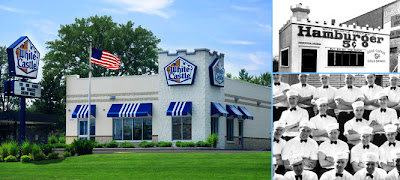 |
| White Castle- Five-Cent Hamburger! |
 |
| Big Boy with a Double-decker |
Finally, I reached chapter 3 that said "The Organization Man." I agreed with the author's introduction immediately: "McDonald's is so powerful an entity, looming so large in the eye of American life, that it's hard to believe it actually started somewhere."
This portion of reading about McDonald's, something that took a significant part in my memories from the childhood absorbed all of my attention and every detail that I learned about McDonald fascinated me.
The McDonald's brothers: Richard and Maurice started the business and Ray Kroc founded the McDonald's, Inc., that "represents America to the world in a way no other business ever has or likely ever will (p51)." I learned that the brothers had the following characteristics: hard-working, imaginative, but lacking visionary aspect or "devotion to systemic conformity." The brothers understood the idea that the fastest product was the best in fast-food business and constructed their business around that idea; they got rid of a dishwashers, flatwares, glasses, tablewares and replaced them with products made out of paper or plastic. They made the making and selling of hamburgers a "continuous process" that eventually brought in $277,000 a year and $100,000 profits by the mid-1950s (p57).
 |
| McDonald's #1 Store Museum |
Apart from the McDonald's brothers, Ray Kroc took away my attention as his strong will and visions were described in detail further into the chapter. The brothers had everything such as yearly Cadillacs, swimming pool, wealth among all, but wives or kids while "Ray Kroc did have a wife and a child and a company of his own: but he risked it all to pursue his dream (p60)." The author states with confidence that McDonaldd today is "purely a product of Kroc's personality;" flawed, troubled, famously difficult, irascible, intolerant, and narrow, he is described in page 61. I knew by this description that a key and a hidden card to success is at times being stubborn and uncompromising in order to maintain order in business.
"McDonald's is not... a hamburger corporation at all. It is a confederation of entrepreneurs, small businesspeople operating according to standards devised by a central organizing authority."
Learning history of many hamburger businesses such as White Castle, Big Boy and McDonalds made me feel enriched as an individual learning about the hamburger as an icon and made me eagerly anticipate for the next reading.



